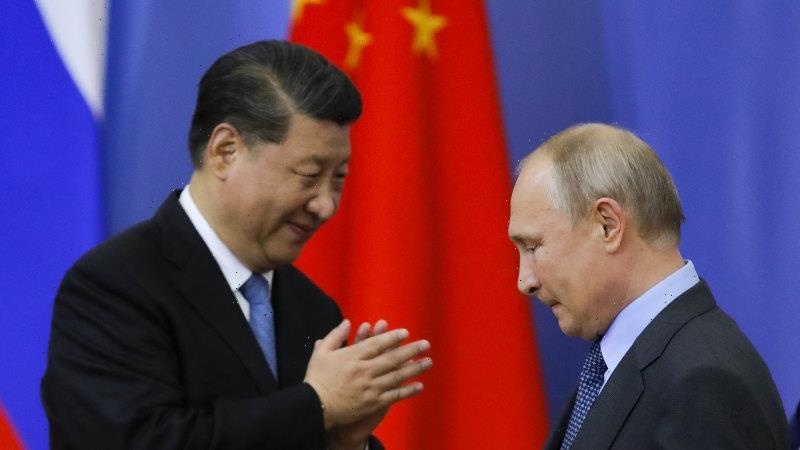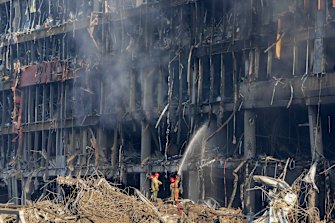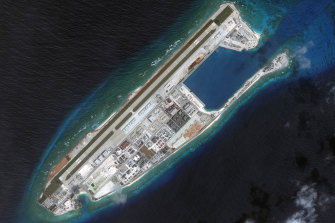Russia is like a hurricane when it moves to take territory, striking hard and fast and directly, while China is like climate change – it moves carefully, gradually, systematically to take over an entire ecosystem.
You can see it today. Russia smashes its way into Ukraine, butchering everyone in its path as the world recoils in horror.
Putin has smashed his way into Ukraine like a hurricane.Credit:AP
In contrast, China continues its creeping takeover of international territories across a vast swathe of the Earth to Australia’s north, east and south. With few people paying attention.
Russia already is paying a heavy price for its wanton violence and still its success is not assured. China, on the other hand, is winning on all fronts and paying bargain-basement prices.
“China has been more subversive and less obvious than Russia,” observes the New Zealand sinologist, Anne-Marie Brady of Canterbury University.
China’s inroads in Solomon Islands have captured headlines in recent days, but it’s only one part of a much bigger picture. Beijing’s South Pacific probings have been described by Euan Graham of the International Institute for Strategic Studies in Singapore as “a pre-conflict type of shadow game”.
But look more broadly. Beijing today is advancing its thrust into the South Pacific, consolidating its control of the South China Sea and expanding its footprint in Antarctica. These three areas, curving across a vast 15,000 kilometre arc from Asia to the South Pole, are essential theatres in its strategy for Indo-Pacific dominance.
Brady says that, in each case, Australia, New Zealand and the US have failed to comprehend China’s plans until it is too late to counter them.
China has built, or is seeking to build, new bases in all three regions. None starts out as overtly military, but Beijing specialises in building infrastructure that is supposedly civilian, only to add military functions later. This has been a highly effective tactic in its incremental expansion.
The artificial islands built by Beijing in the South China Sea are a case in point. China’s President Xi Jinping said that Beijing never would militarise the islands, all of which are in maritime territories also claimed by China’s neighbours.
Illustration: DysonCredit:The Age
Beijing started to build bases on the islands, but swore that they were for civilian shipping and maritime surveillance only. Now some of those islands bristle with missile arsenals, hardened aircraft hangers and other military hardware.
Two weeks ago, the commander of US forces in the Indo-Pacific, Admiral John Aquilino, said that China apparently had finished building its military bases on three of the islands of the South China Sea. Those are Mischief Reef, Subi Reef and Fiery Cross Reef.
“The function of those islands is to expand the offensive capability of the PRC [People’s Republic of China] beyond their continental shores,” said Aquilino. “They can fly fighters, bombers plus all those offensive capabilities of missile systems.”
The news from Solomon Islands was that its government had drafted a secret “security cooperation” agreement with China.
The deal would create a framework to allow China to send its police forces to the Solomons and for its navy to visit and replenish. Conceivably, it could be extended to allow China a naval base in the country.
If so, China’s closest naval base, now 6000 kilometres away from Australia, suddenly would be 2000 kilometres away.
Imperial Japan had to fight its way to the Solomons in 1942 to establish a base there as part of its campaign for the conquest of the entire Asia-Pacific. China is making good progress towards buying its way to a Solomons base.
New Zealand’s Prime Minister Jacinda Ardern described this as “gravely concerning” as a “potential militarisation of the region”. Australia and the US also raised objections. But Solomons Prime Minister Manasseh Sogavare says that he’ll proceed with the agreement as a matter of the country’s sovereign choice.
Fiery Cross Reef in the Spratly Islands has been fully developed by China .Credit:Maxar/AP
Canberra had plenty of notice. For instance, Solomons Opposition Leader Matthew Wale told the ABC that he’d warned Australia around August 2021 that such a deal was in the works.
“The whole Pacific step-up hasn’t worked,” says the ANU’s Stephen Howes, an expert on Pacific aid, referring to the Morrison government’s signature Pacific islands policy. “It’s inevitable that there will be more of this type of agreement. First, China is more powerful and, second, there’s no consequence for these countries. As soon as we found out about this agreement, the Foreign Minister Marise Payne put out a press release announcing more aid money for the Solomons.”
Indeed, Australia is by far the biggest aid donor to Solomon Islands, a low-income country of some 650,000 people. But Beijing is the biggest donor to its government members of parliament.
One example: The Sogavare government controversially switched the Solomons diplomatic recognition from Taiwan to Beijing in 2019. The unpopularity of the decision helped sparked unrest in December last year.
The opposition moved a motion of no confidence against Sogavare as a result. The government paid 250,000 Solomon Islands dollars, about $40,000, to each MP who voted to support Sogavare in successfully surviving the motion. The money, all declared and paid from the National Development Fund, is funded by the Chinese government.
And then there’s the Antarctic, 42 per cent of which is Australian territory. Anne-Marie Brady first warned five years ago that Canberra was being blindsided by Beijing, which had conducted “undeclared military activities and mineral exploration” on Australian territory under the guise of scientific expeditions.
Antarctica is essential to Beijing’s plan. China’s recently completed satellite-based global positioning system, Baidou, depends on its ground stations there.
Beyond that, Brady says that China has designs on the continent’s rich resources and its strategic value for key transport routes. Most of China’s Antarctic activities are on Australian territory, says Brady: “They got to places on Australian territory Australia couldn’t even get to because of a lack of resources. They’ve got what they want now.” She points out that Beijing policy documents assert the right to make a formal territorial claim there.
While Putin’s hurricane rages in Ukraine, Xi quietly is changing the entire geostrategic climate. Australia increasingly will find it uncomfortable to live in a climate where the weather is controlled from Beijing.
Peter Hartcher is international editor.
The Morning Edition newsletter is our guide to the day’s most important and interesting stories, analysis and insights. Sign up here.
Most Viewed in National
From our partners
Source: Read Full Article



